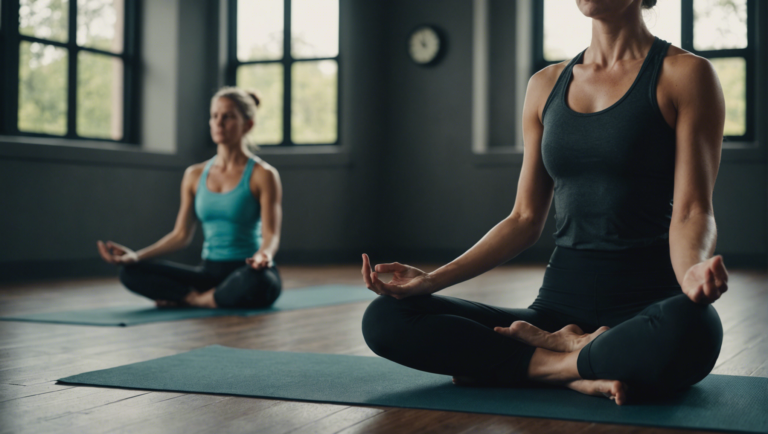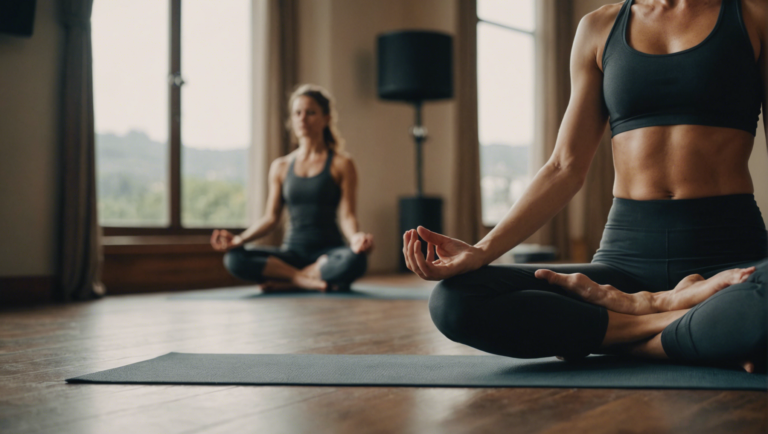Guidelines On How Often To Practice Yoga For Optimal Benefits
Benefits of Regular Yoga Practice
Importance of Consistent Yoga Practice
Engaging in yoga regularly offers a multitude of benefits for both the body and mind. By committing to a consistent practice, individuals can experience improvements in flexibility, strength, balance, and overall well-being. Yoga is not just a physical exercise but a holistic approach to health that combines movement, breathwork, and mindfulness.
Physical Benefits of Regular Yoga Practice
One of the primary advantages of regular yoga practice is enhanced physical fitness. Through various yoga poses and sequences, practitioners can improve their flexibility and range of motion. Additionally, yoga helps to strengthen muscles, leading to better posture and reduced risk of injuries. Over time, consistent yoga practice can also increase stamina and energy levels.
Mental Health Benefits
Yoga is widely celebrated for its positive impact on mental health. Regular practice can help reduce stress and anxiety levels by promoting relaxation and mindfulness. The focus on breathwork in yoga can also improve mental clarity and concentration. Furthermore, the meditative aspects of yoga enable practitioners to cultivate a sense of inner peace and emotional well-being.
Stress Management and Relaxation
In today’s fast-paced world, stress has become a prevalent issue for many individuals. Regular yoga practice provides a sanctuary where individuals can unwind, release tension, and find moments of calm amidst the chaos. The combination of physical movement, deep breathing, and meditation in yoga promotes relaxation and stress relief, ultimately enhancing overall quality of life.
Improved Sleep Quality
Sleep plays a crucial role in maintaining good health, yet many people struggle with sleep-related issues. Practicing yoga on a regular basis has been shown to improve sleep quality by calming the mind and relaxing the body. Certain yoga poses and relaxation techniques can help individuals fall asleep faster, stay asleep longer, and wake up feeling more refreshed.
Enhanced Mind-Body Connection
Yoga emphasizes the connection between the mind and body, encouraging practitioners to be present and fully aware of their physical and mental experiences. By engaging in regular yoga practice, individuals can strengthen this mind-body connection, leading to improved self-awareness, emotional stability, and overall mindfulness.
Long-Term Health Benefits
Consistent yoga practice is associated with a wide range of long-term health benefits. From lowered blood pressure and improved heart health to boosted immunity and increased longevity, the cumulative effects of regular yoga practice can significantly enhance one’s overall health and well-being. By investing time and effort into a consistent yoga routine, individuals can pave the way for a healthier and happier future.
The benefits of regular yoga practice extend far beyond the physical realm, encompassing mental, emotional, and spiritual well-being. By incorporating yoga into your daily routine and committing to a consistent practice, you can experience profound transformations in various aspects of your life. Embrace the journey of yoga practice, reap its countless rewards, and embark on a path towards holistic health and wellness.
Tailoring Your Yoga Schedule to Fit Your Lifestyle
Practicing yoga regularly can have a profound impact on your overall well-being, both physically and mentally. However, finding the right balance in terms of how often to practice is crucial to reap the optimal benefits that yoga has to offer. Tailoring your yoga schedule to fit your lifestyle is key to establishing a sustainable practice that works for you.
Understanding Your Goals and Commitment Level
Before determining how often to practice yoga, it’s important to reflect on your goals and commitment level. Are you looking to improve flexibility, build strength, reduce stress, or enhance mindfulness? Your objectives will influence the frequency of your yoga practice. Additionally, consider how much time you can realistically dedicate to yoga each week based on your schedule and other obligations.
Starting Slow and Gradually Increasing Frequency
If you’re new to yoga, it’s advisable to start slow and gradually increase the frequency of your practice. Begin with 1-2 sessions per week to allow your body to adapt to the movements and postures. As you become more comfortable and confident in your practice, you can consider adding more sessions to your weekly routine. Listen to your body and avoid pushing yourself too hard too soon.
Creating a Consistent Routine
Consistency is key when it comes to yoga practice. Whether you prefer practicing in the morning to start your day on a positive note or in the evening to unwind and relax, establishing a consistent routine can help you stay on track. Choose specific days and times that work best for you and make it a priority to stick to your schedule as much as possible.
Balancing Different Types of Yoga Practices
Yoga offers a variety of styles and practices, each catering to different needs and preferences. To maximize the benefits of your yoga routine, consider incorporating a mix of styles such as Hatha, Vinyasa, Ashtanga, or Yin yoga. Balancing dynamic, physical practices with more gentle, restorative sessions can help prevent burnout and keep your practice enjoyable.
Listening to Your Body and Mind
Beyond following a set schedule, it’s essential to listen to your body and mind throughout your yoga journey. Pay attention to how you feel before, during, and after each practice. If you’re feeling fatigued or experiencing any discomfort, give yourself the permission to take a day off or opt for a gentler practice. Being in tune with your body’s needs is key to practicing yoga mindfully and sustainably.
Adjusting Your Practice as Needed
As life circumstances and priorities evolve, it’s important to be flexible with your yoga practice. There may be times when you’re able to dedicate more time to yoga, while other periods may require you to scale back. Be open to adjusting your practice frequency and intensity based on what feels right for you at any given time. Remember that yoga is a personal journey, and it’s essential to honor your individual needs and limits.
Finding the right balance in how often to practice yoga is a personal endeavor that depends on your goals, lifestyle, and preferences. By understanding your objectives, starting slowly, establishing a consistent routine, exploring different yoga styles, listening to your body, and remaining adaptable, you can create a yoga schedule that supports your well-being and overall health in the long run. So, take the time to tailor your yoga practice to fit your lifestyle accordingly.
Overcoming Challenges in Maintaining a Consistent Yoga Routine
Maintaining a consistent yoga routine can be both incredibly rewarding and challenging. Many individuals struggle to adhere to a regular practice due to various obstacles that can arise. However, overcoming these challenges is possible with the right strategies and mindset in place.
Understanding the Importance of Consistency
Consistency is key when it comes to reaping the full benefits of yoga. A regular practice helps improve flexibility, strength, balance, and overall well-being. It allows for better stress management, increased focus, and a deeper connection between the mind and body. Therefore, establishing a consistent routine is essential for maximizing the advantages of yoga.
Identifying Common Challenges
One of the primary challenges in maintaining a regular yoga practice is time constraints. Balancing work, family, social commitments, and other priorities can make it difficult to carve out dedicated time for yoga. Additionally, lack of motivation, fatigue, and boredom with the routine can also hinder consistency.
Strategies for Overcoming Challenges
Setting Realistic Goals
Begin by setting achievable goals that align with your schedule and lifestyle. Start with shorter practice sessions and gradually increase the duration as you build consistency. By setting realistic expectations, you can prevent burnout and stay committed in the long run.
Creating a Dedicated Space
Designate a specific area in your home for practicing yoga. A clutter-free, peaceful environment can help set the right mood and mindset for your sessions. Having a dedicated space also eliminates the need to set up and pack away your mat each time, making it easier to jump into practice.
Finding Accountability Partners
Consider practicing yoga with a friend, joining a group class, or enlisting the support of a mentor or coach. Being accountable to others can help you stay motivated and committed to your routine. Sharing your progress, challenges, and achievements with someone can make the journey more enjoyable and sustainable.
Exploring Different Yoga Styles
If you find yourself getting bored or unmotivated with your current routine, explore different yoga styles and classes. Trying new practices such as vinyasa, yin, or power yoga can reignite your passion for the practice and keep things fresh and exciting.
Embracing Mindfulness and Self-Compassion
Be gentle with yourself on days when sticking to your routine feels challenging. Practice self-compassion and mindfulness by accepting setbacks without judgment. Remember that consistency is about progress, not perfection. Celebrate small victories along the way and acknowledge the effort you put into showing up on the mat.
In
Maintaining a consistent yoga routine requires dedication, patience, and resilience. By understanding the importance of consistency, identifying common challenges, and implementing effective strategies, you can overcome obstacles and cultivate a sustainable practice. Remember that yoga is a personal journey, and it’s okay to have ups and downs along the way. Stay focused on your goals, prioritize self-care, and enjoy the transformative benefits of a regular yoga practice.
Incorporating Variety in Your Yoga Practice for Maximum Results
Variety in Your Yoga Practice for Maximum Results
Practicing yoga is not only about the physical exercise but also about finding balance, inner peace, and overall well-being. One way to ensure that you are reaping the maximum benefits from your yoga practice is by incorporating variety into your routine. By introducing different styles, poses, durations, and intensity levels, you can challenge your body and mind in new ways, leading to enhanced results and a deeper connection with your practice.
Benefits of Variety in Yoga Practice
Introducing variety into your yoga practice can offer a myriad of benefits. Firstly, it helps prevent boredom and plateaus. Doing the same routine repeatedly can lead to a lack of interest and diminished results. By mixing things up, you keep your practice fresh and exciting, motivating you to stay consistent.
Secondly, incorporating different styles and poses allows you to target various muscle groups and aspects of your physical and mental health. For example, dynamic styles like Vinyasa can improve stamina and cardiovascular health, while restorative practices like Yin yoga can enhance flexibility and relaxation.
How Often Should You Change Your Yoga Routine?
The frequency of switching up your yoga routine varies from person to person. Some practitioners thrive on routine and may prefer to stick to a familiar sequence for an extended period. Others may enjoy the novelty and challenge of trying something new every session. Listen to your body and intuition to determine what approach works best for you.
A general guideline is to introduce some form of variation every 4-6 weeks. This could mean trying a different style of yoga, incorporating new poses, adjusting the duration of your practice, or attending classes led by different instructors. Small changes can make a big difference in how your body responds to the practice.
Balancing Consistency and Variety
While variety is essential for optimal results, consistency is equally important. It is essential to strike a balance between the two. Consistency helps build discipline, establish a routine, and track progress over time. On the other hand, variety keeps your practice engaging, challenges your body in new ways, and prevents monotony.
One way to achieve this balance is by having a core routine that you follow consistently while incorporating variations as needed. For example, you can designate certain days for specific styles of yoga while leaving room for experimentation on other days. This way, you can enjoy the best of both worlds.
Variety in your yoga practice is key to maximizing the benefits you reap from each session. By blending consistency with diversity, you can keep your practice stimulating, effective, and enjoyable. Whether you are a seasoned yogi or a beginner, don’t be afraid to step out of your comfort zone and explore the vast world of yoga to discover what works best for you.
Connecting Mind, Body, and Soul: The Holistic Approach to Yoga
Yoga is a practice that goes beyond physical exercise; it encompasses a holistic approach to connecting the mind, body, and soul. By harmonizing these elements, individuals can achieve a sense of balance, inner peace, and overall well-being. Engaging in yoga not only strengthens the body but also calms the mind and nurtures the spirit. This article explores the holistic benefits of yoga and how it can transform lives by fostering a deeper connection between the mind, body, and soul.
The Mind-Body Connection in Yoga
Central to the practice of yoga is the integration of the mind and body. Through various postures (asanas), breathing techniques (pranayama), and meditation, individuals can cultivate mindfulness and enhance their overall mental well-being. The postures in yoga help improve flexibility, strength, and balance while also promoting relaxation and reducing stress. As individuals focus on performing each pose with awareness and intention, they develop a deeper connection between their physical actions and mental state.
Nurturing the Soul Through Yoga
In addition to benefiting the mind and body, yoga also nurtures the soul. The practice of yoga encourages self-reflection, introspection, and self-discovery. By turning inward and connecting with their inner selves, individuals can cultivate a sense of peace, contentment, and spiritual fulfillment. Through meditation and mindfulness practices, yoga offers a pathway to tap into the soul’s wisdom, leading to a more profound understanding of oneself and the world around them.
Finding Balance and Harmony
Yoga serves as a powerful tool for finding balance and harmony within oneself. In today’s fast-paced world, many individuals experience high levels of stress, anxiety, and overwhelm. Yoga provides a sanctuary where individuals can slow down, tune into their bodies, and quiet the fluctuations of the mind. By practicing yoga regularly, individuals can restore balance, increase self-awareness, and foster a sense of inner harmony that extends beyond the mat and into their daily lives.
The Holistic Benefits of a Regular Yoga Practice
To fully reap the holistic benefits of yoga, it is essential to cultivate a regular practice. The frequency of yoga practice varies among individuals based on their goals, schedules, and level of commitment. For beginners, starting with a few sessions per week can help establish a foundation and gradually increase over time. Intermediate and advanced practitioners may choose to practice yoga daily to deepen their connection with the mind, body, and soul.
Yoga offers a holistic approach to wellness by integrating the mind, body, and soul. By nurturing the mind-body connection, fostering soulful introspection, and promoting balance and harmony, yoga has the power to transform lives from the inside out. Whether you are a beginner or an experienced practitioner, committing to a regular yoga practice can unlock a world of benefits that extend far beyond the physical postures. Embrace the holistic nature of yoga and embark on a journey of self-discovery, growth, and transformation.
Conclusion
A holistic approach to yoga practice can truly transform your overall well-being. By embracing the connection between mind, body, and soul, you will not only experience physical benefits such as increased flexibility and strength but also mental clarity and emotional balance. This integrated approach allows you to tap into the full potential of yoga, leading to a more profound sense of self-awareness and alignment.
Tailoring your yoga schedule to fit your lifestyle is key to maintaining a consistent practice. Whether you prefer to practice in the early morning to start your day with a sense of calm and focus or in the evening to unwind and release tension, finding a routine that works for you is essential. By prioritizing your practice and setting realistic goals, you can establish a sustainable yoga routine that aligns with your individual needs and commitments.
Overcoming challenges in maintaining a consistent yoga routine may require a shift in mindset and a commitment to self-discipline. Recognizing the benefits of regular practice and the positive impact it has on your overall well-being can serve as motivation to overcome obstacles such as time constraints or fatigue. By staying flexible and adaptable in your approach, you can navigate through challenges and stay dedicated to your yoga journey.
Integrating variety into your yoga practice is crucial for preventing plateaus and maximizing results. Exploring different styles, poses, and sequences can help you engage different muscle groups, enhance your flexibility, and deepen your practice. By incorporating elements of challenge and novelty, you can keep your practice exciting and invigorating, allowing for continuous growth and transformation on and off the mat.
The benefits of regular yoga practice extend far beyond physical fitness, encompassing mental, emotional, and spiritual aspects of well-being. By committing to a consistent practice, you empower yourself to cultivate strength, resilience, and mindfulness both on and off the mat. Through dedication, self-awareness, and a willingness to explore new horizons within your practice, you can unlock the full potential of yoga as a holistic tool for self-discovery and personal growth.
By understanding the optimal frequency of practice based on your individual needs and goals, you can harness the transformative power of yoga to enrich your life on a multidimensional level. Embrace the journey of self-discovery, growth, and connection that yoga offers, and let your practice be a reflection of your commitment to cultivating a balanced, harmonious, and vibrant existence.


